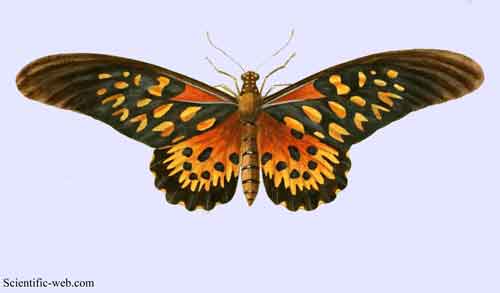
Papilio antimachus
Superregnum: Eukaryota
Cladus: Unikonta
Cladus: Opisthokonta
Cladus: Holozoa
Regnum: Animalia
Subregnum: Eumetazoa
Cladus: Bilateria
Cladus: Nephrozoa
Cladus: Protostomia
Cladus: Ecdysozoa
Cladus: Panarthropoda
Phylum: Arthropoda
Subphylum: Hexapoda
Classis: Insecta
Cladus: Dicondylia
Subclassis: Pterygota
Cladus: Metapterygota
Infraclassis: Neoptera
Cladus: Eumetabola
Cladus: Endopterygota
Superordo: Panorpida
Cladus: Amphiesmenoptera
Ordo: Lepidoptera
Subordo: Glossata
Cladus: Coelolepida
Cladus: Myoglossata
Cladus: Neolepidoptera
Infraordo: Heteroneura
Cladus: Eulepidoptera
Cladus: Ditrysia
Cladus: Apoditrysia
Cladus: Obtectomera
Superfamilia: Papilionoidea
Familia: Papilionidae
Subfamilia: Papilioninae
Tribus: Papilionini
Genus: Papilio
Subgenus: Papilio (Druryia)
Species: Papilio antimachus
Subspecies: P. a. antimachus – P. a. parva
Name
Papilio antimachus Drury, 1782
References
Additional references
Jackson, T.H.E. 1956. Notes on the Rhopalocera of the Kigezi district of Uganda with descriptions of new species and subspecies. Journal of the East Africa Natural History Society 23(1): 63–102. full article (BHL). Reference page.
Vernacular names
English: Giant African Swallowtail
Papilio antimachus, the African giant swallowtail, is a butterfly in the family Papilionidae. With a wingspan between 18 and 23 centimetres (7.1 and 9.1 in), it is the largest butterfly in Africa and among the largest butterflies in the world. The wings are long and narrow and the ground colour is orange brown with black markings. P. antimachus live in the tropical rainforests of west and central Africa. The distribution area (range) stretches from Angola, Cameroon, Democratic Republic of the Congo, Republic of the Congo, Gabon, Ghana, Ivory Coast, Liberia, Nigeria, Sierra Leone, and Uganda. It is much rarer in the west of its range (Guinea to Cameroon) than in the eastern parts of its range. It probably stays in forest canopy but males come down to mud-puddle. The male is larger than the female and can be seen in groups at nectar. The females show themselves less, continually flying high above the tree tops. It has been seen hill-topping in Liberia.[3] The butterfly may have no natural enemies because it is very toxic.The larval foodplant is unknown and nothing is published on the early stages (egg, larva, pupa).Cardiac glycosides found in the larva indicate that the larval foodplant is an asclepiad vine.
Female
Subspecies
Papilio antimachus antimachus (Guinea, Sierra Leone, Liberia, Ivory Coast, Ghana, Togo, southern Nigeria, Cameroon, Gabon, Congo, Central African Republic, western Democratic Republic of the Congo, southern Sudan, northern Angola)
Papilio antimachus parva Jackson, 1956 (eastern Democratic Republic of the Congo, Uganda) [4][5]
References
Drury, D. 1782. Illustrations of Natural History 3: xxvi, 1-769 + 2pp. London.
Papilio, Site of Markku Savela
Sáfián, Sz. (2013). Observation of hill-topping behaviour by the Giant African Swallowtail - Papilio antimachus Drury, 1782 and other recent records from Liberia (West Africa) (Lepidoptera: Papilionidae). Shilap Revista de Lepidopterología. 41(163):323-329..
Jackson, 1956 Notes on the Rhopalocera of the Kigezi District of Uganda with descriptions of new species and subspecies J. E Afr. Nat. Hist. Soc. 23 (1) : 63-102, pl. 1-13 Full text
"Afrotropical Butterflies: File C – Papilionidae - Tribe Papilionini". Archived from the original on 2014-02-22. Retrieved 2012-05-09.
External links
Butterflycorner Images from Naturhistorisches Museum Wien
Tropical and subtropical moist broadleaf forests - WWF Terrestrial Ecoregions
Retrieved from "http://en.wikipedia.org/"
All text is available under the terms of the GNU Free Documentation License

